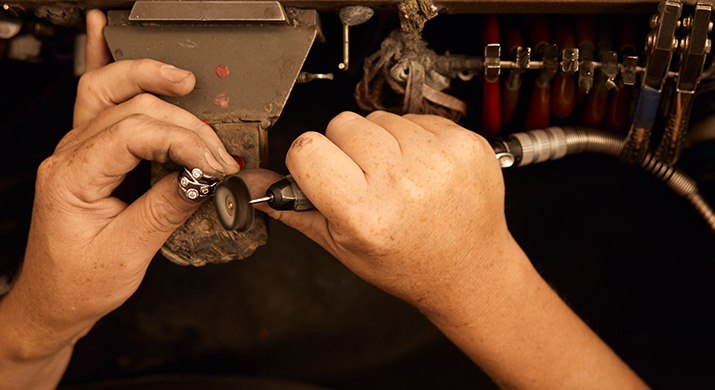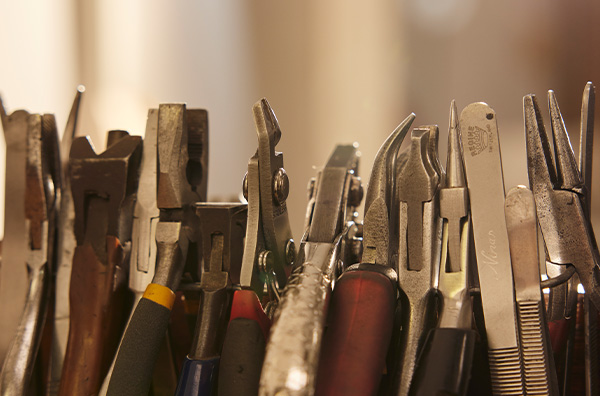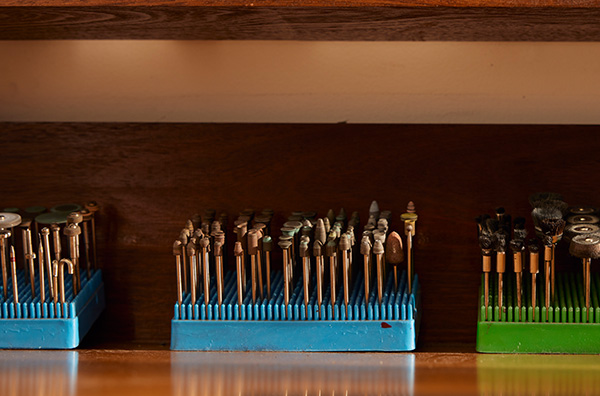How does ring resizing work?


Does your favourite ring feel a little too loose or snug lately? Maybe it's a cherished heirloom you inherited or an engagement ring that fit perfectly when you bought it but no longer does. Whatever the reason, resizing your ring might make it wearable again.
The process involves several intricate steps–from the initial inspection to polishing. We have created this guide to ring resizing so you know exactly what to expect when you take your ring to your jeweller.
How ring resizing works
Initial ring inspection
Before the jeweller resizes your ring, they inspect it thoroughly. This step helps determine the best resizing method and identifies potential obstacles. Here's what happens:
- The jeweller will first identify the type of metal your ring is made of, which can limit the ability to resize. Different metals have varying properties and respond differently to resizing techniques and some cannot be resized. (See the FAQ section below).
- The ring's design complexity will be examined. Intricate details, gemstones, or settings can sometimes complicate the process, requiring specialised methods or even ruling out certain techniques altogether.
- The jeweller will look for tiny markings on the ring band, known as hallmarks. They reveal valuable information like metal purity, manufacturer, and date. This knowledge guides the jeweller in choosing the appropriate tools and materials for a seamless fit.
After the initial inspection, the jeweller will explain whether resizing is possible. If not, they will offer any alternative options you might have.
Determining size adjustment

Once the jeweller confirms your ring can be resized, they will measure your finger using specialised gauges or mandrels. These tools accurately read your knuckle diameter and finger size, ensuring the resized ring doesn’t pinch or slip at rest and when flexed.
The jeweller will then compare the measured diameter to the current ring size to determine the precise adjustment needed to achieve the perfect ring size.
Based on the measured size and ring characteristics, the jeweller will discuss available resizing options and whether it will involve minor adjustments like a half size or larger size changes. They will also usually explain the pros and cons of each option, considering factors like cost, impact on the ring's design, and potential risks or changes to gemstones or settings.
Resizing the ring
After taking all the needed measurements, the jeweller will start with the resizing. There are many techniques, depending on whether you need the ring to be made larger or smaller.
Making the ring smaller
For significant size reductions, the jeweller will carefully cut a small section from the band, typically from the underside. The remaining ends are then meticulously re-joined using soldering techniques, leaving no visible trace of the alteration. This is called ring cutting.
For minor adjustments or if you don’t want to alter your ring design, a jeweller might suggest inserting a sizing bar or ring guard within the band. These temporary solutions offer a snug fit without any permanent modifications.
Making the ring larger
Making a ring bigger usually involves removing a section of the band and then replacing it with a piece of new compatible metal to make it the correct size. The jeweller will then carefully polish the additional section to seamlessly integrate it into the original ring, maintaining its integrity and design.
For smaller adjustments, the jeweller can carefully stretch the ring band using heat and specialised tools. This technique gently expands the metal without compromising its strength or appearance.
In some cases, the jeweller may need to file down the inner edges of the band to make it larger. This technique is typically used for thicker rings.
Finishing and polishing
The penultimate step is finishing and polishing. The technique is based on the ring's material and surface texture. For instance, gold and silver receive a buffing with progressively finer polishing compounds to gradually remove any minor scratches or marks left from the process.
For the gemstones, the jeweller might use soft cloths or specialised brushes to polish the facets. They also ensure the precious stones remain firmly in place.
Rings with enamel, engravings, or intricate details might require specific approaches to preserve their unique textures and details. A reputable jeweller has special techniques and tools to ensure even delicate elements receive the necessary care and attention while ensuring an exact fit.
Final inspection
After the resizing work is complete, the jeweller thoroughly examines the resized ring, scrutinising every detail for any imperfections. If sections were added or removed, the jeweller ensures the soldering is flawless and invisible, with no gaps or uneven sections. They will also double-check if the ring maintained its shape and that it's even all over.
They also check any stone settings are secure.
Once the visual inspection is complete, the jeweller takes one final size measurement to ensure it's the correct ring size and invites you to try on the resized ring so you can feel the fit first hand and confirm it's your desired size. Don't hesitate to express any concerns or adjustments you might need.
Ring resizing FAQs
Which rings cannot be resized?
While most rings can be resized, certain materials and designs present unique challenges, making them either difficult or impossible to resize.
Platinum, titanium and stainless steel rings, for example, are incredibly strong, making them resistant to resizing techniques. While some jewellers might attempt minor adjustments, significant size changes are often impractical or impossible. So as a general rule, avoid resizing if your ring is made of these materials.
Rings with intricate engravings, delicate filigree, or gemstones embedded in the band--like eternity rings--can also be tricky to resize. Adding or removing metal might disrupt the design, which can compromise the ring's aesthetics.
If a ring cannot be resized, it may need to be remade - using the existing stones and your desired ring size, a reputable jeweller (like Nina’s Jewellery’s Master Jewellers) can also do this for you.
How many sizes can a ring be resized?
The most common range for resizing without compromising the ring's integrity is two to three sizes. But for plain bands without stones or intricate designs, it can be up to six sizes. Solitaire rings can also be resized significantly, up to five sizes, as long as the shoulders (metal on either side of the stone) are simple.
Can any jeweller resize a ring?
Resizing requires a specific skill set, the right tools, and a deep understanding of different metals and techniques, and not all jewellers can do that. Your best bet is a reputable jeweller with extensive experience in ring resizing.

Look for jewellers with a proven track record in ring resizing, especially for complex designs or challenging materials. If your ring features valuable gemstones, consider consulting a jeweller specialising in working with those stones. They'll have the knowledge and skills to handle them safely during resizing.
If your ring is relatively new or purchased from a reputable brand, they might offer in-house ring resizing services (or free resizing even) or partner with skilled jewellers. This option is convenient, especially if the ring is still under warranty.
Does a ring lose value when resized?
In most cases, professional ring sizing shouldn't decrease your ring's value. A skilled jeweller can resize rings seamlessly, leaving no visible marks or compromising the ring's integrity. The main purpose of resizing is to make the ring more wearable and enjoyable, which can actually increase its value for the current owner. So always choose a reputable and experienced jeweller.
If your ring has very intricate designs or is made of challenging materials, discuss the limitations with the jeweller to understand the potential risks and the impact of resizing on its value. The same principle applies to an antique or collectible ring.
How much does it cost to get a ring resized?
The price tag for ring resizing depends on what type of resizing you need (shrinking is generally less expensive than enlarging), your ring’s material and design, and the complexity of the resizing process.
How long does ring resizing take? Can it be resized on the same day?
Unfortunately, there's no one-size-fits-all answer to how long ring resizing takes. Simpler rings with minimal design elements will generally be resized faster than those with intricate details or gemstones.
Stretching or shrinking can be done fairly quickly, while adding or removing metal can take longer.
The best way to get a definitive timeframe is to ask your jeweller directly. They can assess your specific ring and chosen resizing method to provide a more accurate estimate.
Need a ring resized or have other questions?
Nina’s is here to help! Whether you’ve misread a ring size chart, chosen to secretly measure someone’s ring size and gotten it wrong, or just need a new ring fit, our experts can help. Contact us today or book a consultation with our team.
Fact-checked by Laura Brown, GIA Certified Diamond & Design Specialist and Sales Manager





The information below is required for social login
LOG IN
Create New Account